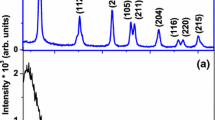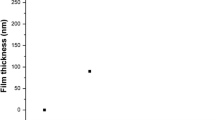Abstract
Anatase titania thin films were prepared by hydrothermal assisted sol-gel dip coating at two different hydrothermal temperatures: 90 °C and 180 °C for 12 h each. Some of the as-deposited films were annealed at 500 °C for 6 h. Both as-deposited and annealed films consisted of tiny spherical particles. Crystallite size and particle size increased with increased hydrothermal temperature and annealing. Atomic force microscopy showed that root mean square and average surface roughness increased with increased hydrothermal temperature and annealing. The prepared films exhibited almost zero transmittance in the violet-ultraviolet transition region with a gradual rise in the visible region up to a maximum value of ~40% at the near infrared. The transmission decreased for annealed films and as hydrothermal temperature was increased. Band gap values did not show any significant difference before and after annealing, although they decreased with increased hydrothermal temperature. Improved crystallinity and greater packing density at higher hydrothermal temperature and annealing led to a corresponding increase in the refractive index. The intensity of photoluminescence peaks was quenched when samples were annealed and as the hydrothermal temperature increased, because of annihilation of oxygen vacant states by the ambient oxygen. Improved crystallinity diminished the number of defect sites in the films, thus reducing the amount of radiative recombination of the e‒/h+ pair. Annealed samples and those prepared from sols processed at higher hydrothermal temperature showed better photocatalytic activity. The maximum degradation efficiency of 62.8% was demonstrated by annealed thin films prepared from sols hydrothermally processed at180 °C after 90 minutes of UV irradiation.

Graphical abstract
Highlights
-
Anatase TiO2 was obtained in an autoclave at low temperature (90 °C). The phase remained unaltered after annealing at 500 °C and also at elevated hydrothermal synthesis temperature of 180 °C.
-
Agglomerated spherical particles were produced with Gaussian type size distribution.
-
Higher preparation temperature and annealing quenched the photoluminescence (PL) intensity that eventually increased efficiency of photo-degradation process.
-
Efficient photodegradation was achieved only after 90 minutes of UV irradiation with a very small area thin film photocatalyst (1.5 cm ⨯ 1 cm).
















Similar content being viewed by others
References
Bennett JM, Pelletier E, Albrand G, Borgogno JP, Lazarides B, Carniglia CK, Schmell RA, Allen TH, Tuttle-Hart T, Guenther KH, Saxer A (1989) Comparison of the properties of titanium dioxide films prepared by various techniques. Appl Opt 28(16):3303–3317
Chen JS, Chao S, Kao JS, Lai GR, Wang WH (1997) Substrate-dependent optical absorption characteristics of titanium dioxide thin films. Appl Opt 36(19):4403–4408
Laube M, Rauch F, Ottermann C, Anderson O, Bange K (1996) Density of thin TiO2 films. Phys Res Sect B 113(1-4):288–292
Pulker HK, Paesold G, Ritter E (1976) Refractive indices of TiO2 films produced by reactive evaporation of various titanium–oxygen phases. Appl Opt 15(12):2986–2991
Tipparach U, Wongwanwatthana P, Sompan T, Saipin T, Krongkitsiri P (2008) Preparation and characterization of nano-TiO2 thin films by sol-gel dip-coating method. Nanotechnology 7:129–136
Tahar T, Mohamed A, Ilhem H, Azeddine C, Boubekeur B, Alexis F, Azzedine B, Abdellaziz D (2014) Effects of dip-coating speed and annealing temperature on structural, morphological and optical properties of sol-gel nanostructured TiO2 thin films. Eur Phys J Appl Phys 67(3):30302
Pedrini LFK, Escaliante LC, Scalvi LVA (2021) Deposition of TiO2 thin Films by Dip-Coating Technique from a Two-Phase Solution Method and Application to Photocatalysis. Materials Research 24.
Hengbo Y, Yuji W, Takayuki K, Shingo K, Sadao M, Hirotaro M, Takao S, Shozo Y (2001) Hydrothermal synthesis of nanosized anatase and rutile TiO2 using amorphous phase TiO2. J Mater Chem 11:1694–1703
Song S, Jing L, Li S, Fu H, Luan Y (2008) Superhydrophilic anatase TiO2 film with the micro-and nanometer-scale hierarchical surface structure. Mater Lett 62(20):3503–3505
Jia-Guo Y, Huo-Gen Y, Bei C, Xiu-Jian Z, Jimmy CY, Wing-Kei H (2003) The Effect of Calcination Temperature on the Surface Microstructure and Photocatalytic Activity of TiO2 Thin Films Prepared by Liquid Phase Deposition. J Phys Chem B 107(50):13871–13879
Angulo-Ibáñez A, Goitandia AM, Albo J, Aranzabe E, Beobide G, Castillo O, Pérez-Yáñez S (2021) Porous TiO2 thin film-based photocatalytic windows for an enhanced operation of optofluidic microreactors in CO2 conversion. Iscience 24(6):102654.
Naoki S, Hiroshi S (2021) Influence of vacuum environment on photocatalytic degradation of methyl red by TiO2 thin film. Acta Astronautica 178:693–699
Jinyu Z, Hua Y, Xinjun L, Shanqing Z (2008) Enhanced photocatalytic activity of TiO2 nano-structured thin film with a silver hierarchical configuration. Appl Surf Sci 254(6):1630–1635
Baba K, Simon B, Patrick C, Boscher ND (2017) Photocatalytic anatase TiO2 thin films on polymer optical fiber using atmospheric-pressure plasma. ACS Appl Mater interfaces 9(15):13733–13741
Sreethawong T, Ngamsinlapasathian S, Yoshikawa S (2014) Positive role of incorporating P-25 TiO2 to mesoporous-assembled TiO2 thin films for improving photocatalytic dye degradation efficiency. J Colloid Interface Sci 430:184–192. https://doi.org/10.1016/j.jcis.2014.05.032
Rahman KH, Kar AK (2021) Oxygen Vacancy and Adsorbed Superoxides Dependent Photocatalytic Activity of TiO2 Quantum Dot Thin Films for Degradation of Methylene Blue with Variation of Precursor Concentration. ECS J Solid State Sci Technol 10(8):081011
Ge L, Xu M, Fang H, Sun M (2006) Preparation of TiO2 thin films from autoclaved sol containing needle-like anatase crystals. Appl Surf Sci 253(2):720–725
Yuan J, Tsujikawa S (1995) Characterization of sol‐gel‐derived TiO2 coatings and their photoeffects on copper substrates. J Electrochem Soc 142(10):3444
Dutta S, Leeladhar, Pandey A, Thakur OP, Pal R (2015) Electrical properties of ultrathin titanium dioxide films on silicon. J Vac Sci Technol A: Vac, Surf, Films 33(2):021507. https://doi.org/10.1116/1.4904978
Karuppasamy A, Subrahmanyam A (2007) Studies on the room temperature growth of nanoanatase phase TiO2 thin films by pulsed DC magnetron with oxygen as sputter gas. J Appl Phys 101(6):064318
Wang M, Wang J, Chen W, Cui Y, Wang L (2006) Effect of preheating and annealing temperatures on quality characteristics of ZnO thin film prepared by sol–gel method. Mater Chem Phys 97:219
Liu YC, Tung SK, Hsieh JH (2006) Influence of annealing on optical properties and surface structure of ZnO thin films. J Cryst growth 287(1):105–111
Lin Y, Xie J, Wang H, Li Y, Chavez C, Lee S, Foltyn SR, Crooker SA, Burrell AK, McCleskey TM, Jia QX (2005) Green luminescent zinc oxide films prepared by polymer-assisted deposition with rapid thermal process. Thin Solid Films 492(1-2):101–104
Arthanarieswaran VP, Kumaravel A, Saravanakumar SS (2015) Physico-chemical properties of alkali-treated Acacia leucophloea fibers. Int J Polym Anal Charact 20(8):704–713
Rajesh Kumar B, Subba Rao T (2012) AFM studies on surface morphology, topography and texture of nanostructured zinc aluminum oxide thin films. Dig J Nanomater Biostruct 7(4):1881–1889
Rough Surfaces; HC Ward, Rough Surfaces, (1982), Profile Characterization, Chapter 4 in: TR Thomas Ed., Longman, London
Lekshmy SS, Daniel GP, Joy K (2013) Microstructure and physical properties of sol gel derived SnO : Sb thin films for optoelectronic applications. Appl Surf Sci 274:95–100
Shei S.-C., (2013) Optical and Structural Properties of Titanium Dioxide Films from TiO2 and Ti3O5 Starting Materials Annealed at Various Temperatures. Adv Mater Sci Eng, 2013: 1–7; 545076; https://doi.org/10.1155/2013/545076
Zhang F, Zheng Z, Ding X, Mao Y, Chen Y, Zhou Z, Yang S, Liu X (1997) Highly oriented rutile-type TiO2 films synthesized by ion beam enhanced deposition. J Vac Sci Technol A: Vac, Surf, Films 15(4):1824–1827
Fujii T, Sakata N, Takada J, Miura Y, Daitoh Y, Takano M (1994) Characteristics of titanium oxide films deposited by an activated reactive evaporation method. J Mater Res 9(6):1468–1473
Pandiaraman M, Soundararajan N, Vijayan C (2011) Effect of thickness on the optical band gap of silver telluride thin films. J Ovonic Res 7(1):21–27
Humayan Kabir M, Mintu Ali M, Abdul Kaiyum M, Rahman MS (2019) Effect of annealing temperature on structural morphological and optical properties of spray pyrolized Al-doped ZnO thin films. J Phys Commun 3:105007
Bashar MS, Matin R, Sultana M, Siddika A, Rahaman M, Gafur MA, Ahmed F (2020) Effect of rapid thermal annealing on structural and optical properties of ZnS thin films fabricated by RF magnetron sputtering technique. J Theor Appl Phys 14(1):53–63
Kabir MH, Ali MM, Kaiyum MA, Rahman MS (2019) Effect of annealing temperature on structural morphological and optical properties of spray pyrolized Al-doped ZnO thin films. J Phys Commun 3(10):105007
Tan T-T, Liu B-J, Wu Z-H, Liu Z-T (2017) Annealing Effects on Structural, Optical Properties and Laser-Induced Damage Threshold of MgF2 Thin Films. Acta Metall Sin (Engl Lett) 30(1):73–78. https://doi.org/10.1007/s40195-016-0479-x
Sahoo D, Priyadarshini P, Aparimita A, Alagarasan D, Ganesan R, Varadharajaperumal S, Naik R (2020) Role of annealing temperature on optimizing the linear and nonlinear optical properties of As40Se50Ge10 films. RSC Adv 10:26675–26685. https://doi.org/10.1039/D0RA04763E
Loubna C, Tetiana B, Nikolay Polikarpovich K, Djamel H, Sahraoui C, Slimane A (2017) Photoluminescence properties of TiO2 nanofibers. J Nanopart Res 19:129. https://doi.org/10.1007/s11051-017-3822-x
Liu B, Zhao X, Wen L (2006) The structural and photoluminescence studies related to the surface of the TiO2 sol prepared by wet chemical method. Mater Sci Eng: B 134(1):27–31
Santara B, Giri PK, Imakita K, Fujii M (2013) Evidence of oxygen vacancy induced room temperature ferromagnetism in solvothermally synthesized undoped TiO2 nanoribbons. Nanoscale 5(12):5476–5488
Lei Y, Zhang LD, Meng GW, Li GH, Zhang XY, Liang CH, Chen W, Wang SX (2001) Preparation and photoluminescence of highly ordered TiO2 nanowire arrays. Appl Phys Lett 78:1125
Zuo F, Wang L, Wu T, Zhang Z, Borchardt D, Feng P (2010) Self-doped Ti3+ enhanced photocatalyst for hydrogen production under visible light. J Am Chem Soc 132:11856
Justicia I, Ordejon P, Canto G, Mozos JL, Fraxedes J, Battiston GA, Gerbasi R, Figueras A (2002) Designed self‐doped titanium oxide thin films for efficient visible‐light photocatalysis. Adv Mater 14:1399
Li FB, Li XZ (2002) Photocatalytic properties of gold/gold ion-modified titanium dioxide for wastewater treatment. Appl Catal A: Gen 228(1-2):15–27
Toyoda T, Hayakawa T, Abe K, Shigenari T, Shen Q (2000) Photoacoustic and photoluminescence characterization of highly porous, polycrystalline TiO2 electrodes made by chemical synthesis. J Lumin 87:1237–1239
Li XQ, Qiao GJ, Chen J (2006) Photodegradation Mechanism of Oxygen Vacancies in Titanium Dioxide Modified by Radio Frequency Plasma J Chin. Ceram Soc 34(12):1466–1469
Acknowledgements
Authors thank the ACMS, IIT Kanpur for providing XRD facility. Authors are grateful to Central Research Facility (CRF), IIT (ISM) Dhanbad for providing UV-Vis NIR spectroscopy, FESEM and AFM facility. We also acknowledge DST-FIST facility (project no. SR/FST/PSI-004/2013) for providing the photoluminescence spectrometer facility.
Author information
Authors and Affiliations
Corresponding author
Ethics declarations
Conflict of interest
We confirm that there are no known conflicts of interest associated with this publication and there has been no significant financial support for this work that could have influenced its outcome. The data that support the findings of this study are available from the corresponding author upon reasonable request. We confirm that the manuscript has been read and approved by all named authors and that there are no other persons who satisfied the criteria for authorship but are not listed. We further confirm that the order of authors listed in the manuscript has been approved by all of us.
Additional information
Publisher’s note Springer Nature remains neutral with regard to jurisdictional claims in published maps and institutional affiliations.
Supplementary Information
Rights and permissions
About this article
Cite this article
Biswas, S., Kar, A.K. Photocatalytic Performance of Hydrothermal Temperature Dependent Dip Coated TiO2 Thin Films. J Sol-Gel Sci Technol 102, 649–664 (2022). https://doi.org/10.1007/s10971-022-05777-1
Received:
Accepted:
Published:
Issue Date:
DOI: https://doi.org/10.1007/s10971-022-05777-1




